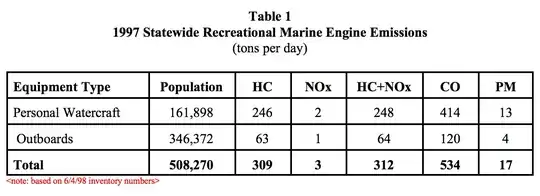Driving a jet ski for one hour will produce the equivalent amount of pollution as driving a new car 100,000 km.
This claim seems to be INCORRECT.
First, the claim appears to be credited to Stienstra (1998):
The state Air Resources Board is also considering taking statewide
action against personal watercraft, after a staff report said that two
hours of exhaust emissions from a Jet Ski is equivalent to the
emissions created by driving a 1998 automobile 130,000 miles.
In addition, the amount of hydrocarbons and nitrogen oxides released
in the air by Jet Skis and outboard motors totaled 312 tons per day.
"Jet Skis produce nine times the hydrocarbon emissions as outboard
motors," said Russell Long of the Bluewater Network in San Francisco,
which has led the national opposition to personal watercraft.
But, after digging deeper, I was able to find the staff report:
Here is an extract from the report published by Air Resources Board has been reviewed by the staff of the California Air Resources Board and approved for publication:
Applicability. The proposed exhaust emission standards are applicable to outboard marine and personal watercraft engines,
including jet boats.
Emissions Impact. Emissions of hydrocarbons (HC) and oxides of nitrogen (NOx) from outboard and personal watercraft in 1997 totaled
312 tons per day. This compares to 1,374 tons per day statewide for
passenger cars. While reductions from gasoline SI marine engines are
not included in California’s SIP as a planned measure for meeting
attainment goals, the impact of outboard and personal watercraft
engines on the state’s total emissions inventory makes control of this
category of emissions necessary. Table 1 lists the relative
contribution of outboard and personal watercraft exhaust emissions in
California in tons per day. As a comparison to other sources, the
exhaust emissions from two hours of personal watercraft operation is
equivalent to the emissions from a 1998 passenger car operated over
100,000 miles.
This regulation is also driven in part by concerns over discharge of unburned fuel into
lakes, reservoirs and waterways. According to studies cited in the U.S. EPA gasoline SI marine engine rulemaking, conventional two-stroke engines discharge 25 to 30 percent of fuel unburned into the water. Recent attention focused on detection of methyl-tertiary-butyl-ether (MTBE) in drinking water supplies has caused a number of water quality agencies to consider restriction of two-stroke watercraft on particular waterways. Other gasoline constituents emitted into the water, including carcinogenic benzene and toluene, have also been of significant concern.

If you look closer, it seems that Stienstra (1998) misinterpreted and/or misunderstood the english behind the report. With the help of our friends from english.stackexchange.com, it can be concluded that:
The official report by Air Resources Board official said that:
As a comparison to other sources, the
exhaust emissions from two hours of personal watercraft operation is
equivalent to the emissions from a 1998 passenger car operated over
100,000 miles.
But it was paraphrased incorrectly by Stienstra (1998):
After a staff report said that two hours of exhaust emissions from a Jet Ski is equivalent to the emissions created by driving a 1998 automobile 130,000 miles.
The correct interpretation (suggested by @Senex) is:
All the watercrafts operating in California together produce in 2 hours the same pollution as one car driven 100,000 km
Explanation:
Prior to what was quoted from the scientific report:
Emissions of hydrocarbons (HC) and oxides of nitrogen (NOx) from outboard and personal watercraft in 1997 totaled 312 tons per day.
That number of tons per day equals 26 tons per 2 hours, which is close to the approximately 26 tons of CO₂E an average car emits while traveling 100,000km.
This figure arises as follows: From the EPA's refs.html, section Miles driven by the average passenger vehicle per year, average car emissions are 4.20 x 10⁻⁴ metric tons CO₂E per mile. For 100,000 miles, that's a total of 42 metric tons CO₂E (CO₂ equivalent, which encompasses “carbon dioxide, methane, and nitrous oxide, all expressed as carbon dioxide equivalents”). Emissions per 100,000 km is about 5/8 as much, or about 26 tons. (More precisely, 26.098 tons = 42 tons * 100000 miles/160934 km, but even two significant digits is too many.)
Stienstra, T. (1998, Jul 08). U.S. park service seeks ban on jet skis 950 square miles of bay area waters would be affected. San Francisco Examiner. Retrieved from http://search.proquest.com/docview/270486538?accountid=8555
The claim:
2 hours of Jet Ski driving are equivalent to 130,000 miles.
2 hours of Jet Ski driving are equivalent 209,215 kilometers.
1 hour of Jet Ski driving is equivalent to 104,607.5 kilometers.
1 hour of Jet Ski driving almost equivalent to 100,000 kilometers.
